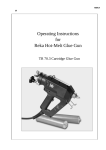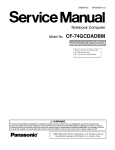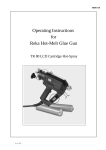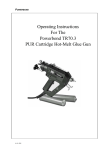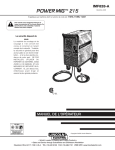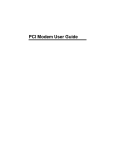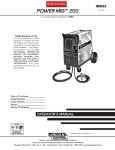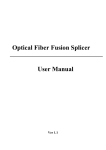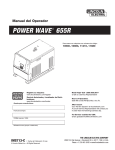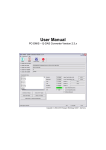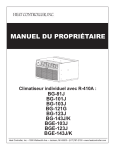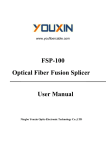Download CLONTECH
Transcript
CLONTECH Innovative Tools to Accelerate Discovery Advantage 2 PCR Enzyme System User Manual ® PT3281-1 (PR11009) Published 23 January 2001 Storage conditions: –20°C FOR RESEARCH USE ONLY Advantage® 2 PCR Enzyme System User Manual Table of Contents I. Introduction 3 II. List of Components 6 III. Additional Materials Required 7 IV. Advantage 2 PCR Protocol 8 A. General Considerations 8 B. Control PCR Reactions 11 C. Recommended Cycling Parameters 12 D. Recommendations for Electrophoresis 13 Troubleshooting Guide 14 VI. References 18 VII. Related Products 18 V. Notice to Purchaser This product is intended to be used for research purposes only. It is not to be used for drug or diagnostic purposes nor is it intended for human use. CLONTECH products may not be resold, modified for resale, or used to manufacture commercial products without written approval of CLONTECH. A license under U.S. patents 4,683,202, 4,683,195, and 4,965,188 or their foreign counterparts, owned by HoffmannLa Roche and F. Hoffmann-La Roche Ltd. (“Roche”), has an up-front fee component and a running-royalty component. The purchase price of this product includes limited, non-transferable rights under the running-royalty component to use only this amount of the product to practice the Polymerase Chain Reaction (“PCR”) and related products described in said patents solely for the research and development activities of the purchaser when this product is used in conjunction with a thermal cycler whose use is covered by the up-front fee component. Rights to the up-front fee component must be obtained by the end-user in order to have a complete license. These rights under the up-front fee component may be purchased from Perkin-Elmer or obtained by purchasing an authorized thermal cycler. No right to perform or offer commercial services of any kind using PCR, including without limitation reporting the results of purchaser’s activity for a fee or other commercial consideration, is hereby granted by implication or estoppel. Further information on purchasing licenses to practice the PCR process may be obtained by contacting the Director of Licensing at the Perkin-Elmer Corporation, 850 Lincoln Centre Drive, Foster City, CA 94404 or at Roche Molecular Systems, Inc., 1145 Atlantic Avenue, Alameda, CA 94501. TaqStart™ Antibody is licensed under U.S. Patent No. 5,338,671 and corresponding patents in other countries. This product is sold under licensing arrangements with F. Hoffmann-La Roche Ltd., Roche Molecular Systems, Inc., and the Perkin-Elmer Corporation. CLONTECH Laboratories, Inc. 2 www.clontech.com Protocol # PT3281-1 Version # PR11009 Advantage® 2 PCR Enzyme System User Manual I. Introduction The Advantage® 2 Polymerase Mix and Advantage® 2 PCR Kit (which includes the Polymerase Mix) allow efficient, accurate, and convenient amplification of DNA from any template. The Advantage 2 Polymerase Mix is comprised of TITANIUM™ Taq DNA Polymerase—a nuclease-deficient N-terminal deletion of Taq DNA polymerase plus TaqStart™ Antibody to provide automatic hot-start PCR (Kellogg et al., 1994)—and a minor amount of a proofreading polymerase. TITANIUM Taq provides the most sensitive and robust capabilities of any Taqderived polymerase. Its increased sensitivity and robust nature are especially useful for amplifying a wide size range of DNA fragments, cDNAs of rare transcripts, or products from complex templates. The higher yields and increased sensitivity that TITANIUM Taq provides translate into two major advantages over conventional polymerases. First, targets can be amplified using fewer PCR cycles, saving time and lowering background in any given experiment. Second, in situations where the amplification target is present at extremely low levels (e.g., amplifying a rare cDNA in an RT-PCR experiment or detecting viral nucleic acid), the high sensitivity obtained with TITANIUM Taq allows successful amplification of your target where other polymerases fail. TITANIUM Taq allows you to perform PCR without tedious buffer optimization. In any given reaction, TITANIUM Taq tolerates a wide range of Mg2+ concentrations. Mg is already included at a set concentration in the Advantage 2 PCR Buffer, eliminating the need to add Mg2+ as a separate component during reaction setup. In contrast, native Taq polymerase only functions well over a narrow [Mg2+ ] range, and different reactions may require different concentrations of Mg2+ . By eliminating the need to perform experiments for determining the optimal Mg2+ concentration, using TITANIUM Taq saves considerable time and effort. The Advantage Polymerase Systems The simultaneous use of two different DNA polymerases (primary and proofreading) in a PCR reaction allows amplification of significantly longer fragments in a process known as long and accurate PCR (or long-distance PCR [LD PCR]; Barnes, 1994; Cheng et al., 1994). However, the usefulness of two-enzyme systems is not limited to LD PCR. In fact, the efficiency of most PCR reactions can be significantly improved by using the two-enzyme combination. Advantage 2 offers three primary benefits over conventional, single-polymerase PCR: — Increased range. Whereas the upper limit of conventional PCR using a Taq polymerase is ~3 kb (and much lower in many applications), Advantage 2 gives consistent and efficient amplifications of up to 18 kb or more when using two nondegenerate primers of sufficient length to amplify an abundant, noncomplex template. It can also amplify high-complexity (i.e., genomic) DNA templates up to 6 kb. The absolute upper limit in any particular Protocol # PT3281-1 Version # PR11009 www.clontech.com CLONTECH Laboratories, Inc. 3 Advantage® 2 PCR Enzyme System User Manual I. Introduction continued application will depend on the particular primers, the template used, and other experimental variables. — Increased fidelity. The inclusion of a minor amount of a proofreading polymerase results in an error rate that is 3-fold lower than that of conventional PCR with Taq alone (Barnes, 1994; Frey et al. , 1995; Nelson et al., 1995). In our studies, Advantage 2 exhibits an error rate of 25 errors per 100,000 bp after 25 PCR cycles. Note that the presence of organic solvents or salts in the reaction can decrease fidelity. High fidelity a particularly important feature when the amplification products will be used in subsequent experiments (e.g., cloning, sequencing, functional assays, expression systems, etc.). — Increased efficiency and greater yields. While range and fidelity are the most commonly noted aspects of long and accurate PCR, the use of a twopolymerase system also increases the efficiency and yield—and therefore the sensitivity—of all PCR assays, even for templates that are well within the range of conventional PCR. While DNA polymerases with proofreading activity offer better accuracy than LD PCR methods when used alone, they lack the increased efficiency and size-range flexibility possible with Advantage 2 for long and accurate PCR. Automatic hot start with TaqStart Antibody Advantage 2 contains built-in, hot-start PCR from TaqStart Antibody included in the polymerase mix. Antibody-mediated hot start with TaqStart has been shown to significantly improve the efficiency and specificity of PCR amplifications by reducing background DNA synthesis (Kellogg et al., 1994; CLONTECHniques, April 1994). Specifically, this antibody reduces or eliminates nonspecific amplification products and primer-dimer artifacts created prior to the onset of thermal cycling. TaqStart is a neutralizing monoclonal antibody that recognizes both native Taq and N-terminal deletions such as TITANIUM Taq. The antibody inhibits enzymatic activity during PCR reaction setup at ambient temperatures. Polymerase activity is restored at the onset of thermal cycling because the antibody is denatured at high temperatures. The loss of inhibition is complete and irreversible, so the polymerase regains its full enzymatic activity for PCR. Besides increased specificity and sensitivity, the built-in hot start in the Advantage 2 Polymerase Mix offers convenience. Other methods of hot start require extra steps such as the addition and premelting of wax beads or the addition of a critical component after the initial denaturation. These extra steps are inconvenient and introduce a potential source of cross-contamination. In contrast, TaqStart provides automatic hot-start PCR with virtually no risk of cross-contamination. Thus, TaqStart provides all the advantages of hot-start PCR—with none of the disadvantages of other hot-start methods. The antibody CLONTECH Laboratories, Inc. 4 www.clontech.com Protocol # PT3281-1 Version # PR11009 Advantage® 2 PCR Enzyme System User Manual I. Introduction continued comes already included in the Advantage 2 Polymerase Mix; there is no need to add it as a separate reagent during PCR setup. What can I use with Advantage 2? The Advantage 2 Mix and Kit are the recommended polymerase systems for use in applications involving RACE, RT-PCR, cDNA synthesis and library construction, cDNA subtraction and differential display, high-performance cloning, and RNA fingerprinting. Advantage 2 has been optimized for use with all of CLONTECH's PCR-based application kits, including SMART™ cDNA Library Construction, SMART™ PCR cDNA Synthesis, SMART™ RACE cDNA Amplification, CLONTECH PCR-Select™ Subtraction Kits, Marathon™ cDNA Amplification, and Delta™ Differential Display. For genomic applications, including CLONTECH's GenomeWalker™ Kits, we recommend Advantage® Genomic Kits. See Related Products (Section VII) for ordering information. Protocol # PT3281-1 Version # PR11009 www.clontech.com CLONTECH Laboratories, Inc. 5 Advantage® 2 PCR Enzyme System User Manual II. List of Co/mponents Advantage 2 PCR Kit (#K1910-y,-1) Store all components at –20°C. Enough reagents are supplied for 30 or 100 PCR reactions of 50 µl each. 30 rxns 100 rxns • 30 µl 100 µl 50X Advantage 2 Polymerase Mix Includes TITANIUM Taq DNA Polymerase, a small amount of proofreading polymerase, and TaqStart Antibody (1.1 µg/µl) in the following storage buffer. Concentration Final rxn in 50X mix Component concentration 50 15 75 0.05 % mM mM mM Glycerol Tris-HCl (pH 8.0) KCl EDTA 1.0 0.3 1.5 1.0 % mM mM µM • 200 µl 600 µl 10X Advantage 2 PCR Buffer Concentration Final rxn in 10X mix Component concentration 400 mM Tricine-KOH (pH 8.7 at 25°C) 40 mM 150 mM KOAc 15 mM 35 mM Mg(OAc)2 3.5 mM 37.5 µg/ml BSA 3.75 µg/ml 0.05 % Tween-20 0.005 % 0.05 % Nonidet-P40 0.005 % • 50 µl 120 µl 50X dNTP Mix (10 mM each of dATP, dCTP, dGTP, and dTTP; final rxn concentration: 0.2 mM each) • 30 µl 100 µl Control DNA Template (100 ng/µl) Calf Thymus DNA • 30 µl 100 µl Control Primer Mix (10 µM each) 5' primer 5'–GCAACTGCAGGAAGAGCAAGAAATGCA–3' 3' primer 5'–TGGCACGGCCATAAGAGGTAGATGTCA–3' • 2.5 ml 5.0 ml PCR-Grade Water CLONTECH Laboratories, Inc. 6 www.clontech.com Protocol # PT3281-1 Version # PR11009 Advantage® 2 PCR Enzyme System User Manual II. List of Components continued Advantage 2 Polymerase Mix (#8430-1, -2) Store all components at –20°C. Enough reagents are supplied for 100 or 500 PCR reactions of 50 µl each. 100 rxns 500 rxns • 100 µl 5 x 100 µl 50X Advantage 2 Polymerase Mix [See page 5 for component concentrations.] • 600 µl 5 x 600 µl 10X Advantage 2 PCR Buffer [See page 5 for component concentrations.] III. Additional Materials Required The following reagents are not supplied. • • [optional] Mineral oil (We recommend Sigma Cat. #M-3516.) 0.5-ml PCR reaction tubes (We recommend Perkin-Elmer GeneAmp 0.5-ml reaction tubes [Cat. #N801-0737 or N801-0180].) • Thermal cycler (Perkin-Elmer GeneAmp 480 or equivalent) • Pipettors dedicated for PCR • PCR pipette tips suitable to the above pipettors and preferably equipped with hydrophobic filters. • DNA size markers (See Section IV.D) • 5X Stop/loading buffer (Sambrook et al. [1989] provides several recipes.) In addition, if you have purchased the Advantage 2 Polymerase Mix alone (#8430-1, -2), you will need the following: • 50X dNTP mix (10 mM each of dATP, dCTP, dGTP, and dTTP) • Appropriate control template and primers Protocol # PT3281-1 Version # PR11009 www.clontech.com CLONTECH Laboratories, Inc. 7 Advantage® 2 PCR Enzyme System User Manual IV. Advantage 2 PCR Protocol PLEASE READ ENTIRE PROTOCOL BEFORE STARTING. A. General Considerations 1. Primer design Primer design is the single largest variable in PCR applications and the single most important factor in determining the success or failure of PCR reactions. Always check and recheck your primer design before constructing or ordering primers. Visit alces.med.umn.edu/VGC.html on the web for helpful guidelines on primer design. Length and G-C content: Advantage 2 can be used in a wide variety of PCR applications, and the constraints on primer design will vary from one application to the next. In general, however, primers should have a Tm of approximately 70°C to achieve optimal results in a two-step cycling program with a 68°C annealing/extension step. Therefore, whenever possible, primers should be at least 22 nucleotides (nt) long (25–30-mers are preferred) and should have a G-C content of 45–60%. Furthermore, the 3'-terminal ends of each primer should not be complementary to each other and should contain a low G-C content. 2. Template quality Because PCR amplification proceeds exponentially, many conventional PCR applications work well with templates of average or even low quality. In many applications such as screening cDNA inserts with CLONTECH's LD Insert Screening Amplimers, long and accurate PCR with Advantage 2 will also tolerate a wide range of template quality. However, the longer or more complex the target, the more important template quality becomes. This is because the number of unnicked, full-length targets decreases as the target length increases, so poorquality DNA will have very few large, unnicked targets. Furthermore, some depurination occurs when DNA is denatured during thermal cycling, and this can lead to truncated products. Therefore, it is particularly important to prepare high-quality, high molecular-weight DNA when amplifying large targets. Template quality is also important when the highest possible sensitivity is needed. In cDNA applications such as RACE and RT-PCR protocols, incomplete reverse transcription can lead to an absence of product, truncated products, or a mix of truncated and fulllength product, resulting in a smeared band on a gel. This problem can be minimized by ensuring that your starting material is of the highest quality. For 5' and 3' RACE and general PCR from cDNA, you can ensure the quality of your cDNA by using Marathon-Ready™ cDNA from CLONTECH. CLONTECH Laboratories, Inc. 8 www.clontech.com Protocol # PT3281-1 Version # PR11009 Advantage® 2 PCR Enzyme System User Manual IV. Advantage 2 PCR Protocol continued 3. Good PCR practices a. Prepare reactions with dedicated pipettors in a dedicated work space Due to the tremendous amplification power of PCR, minute amounts of contaminating DNA can produce nonspecific amplification; in some instances, contaminants can cause DNA bands even in the absence of added template DNA. We recommend that you use small aliquots of starting material to avoid contaminating your stocks. When performing PCR, you should wear gloves and set up your reactions in a dedicated lab area or noncirculating containment hood using dedicated pipettors, PCR pipette tips with hydrophobic filters, and dedicated solutions. We also recommend setting up a negative control reaction that does not contain any template. Finally, perform post-PCR analysis in a separate area using a separate set of pipettors. b. Pipetting Because of the small volumes used in PCR experiments and the potential for tube-to-tube variation, careful pipetting technique is extremely important. Always be sure that no extra solution is on the outside of the pipette tip before transfer. When adding solution to a tube, immerse the tip into the reaction mixture, deliver the contents from the pipette tip into the mixture, and pipet up and down several times. c. Use a Master Mix Assembling a Master Mix, which contains the appropriate volumes of all reagents required for multiple PCR reactions, saves time and greatly reduces tube-to-tube variation. If multiple templates are being tested with the same primers, include the primers in the Master Mix. If one template is being tested with multiple primer sets, include the template in the Master Mix. If you are setting up several sets of parallel samples, assemble multiple Master Mixes (e.g., each with a different set of primers). The Master Mix should be thoroughly mixed before use (i.e., vortexed without bubbling). d. Always include positive and negative controls (i.e., H2O instead of DNA template). 4. Touchdown PCR "Touchdown" PCR can significantly improve the specificity of many PCR reactions in a wide variety of applications (Don et al., 1991; Roux, 1995). Briefly, touchdown PCR involves using an annealing/extension temperature that is several degrees (typically 3–10°C) higher than the Tm of the primers during the initial PCR cycles (typically 5–10 cycles). The annealing/extension temperature is then reduced to the primer Tm for the remaining PCR cycles. Protocol # PT3281-1 Version # PR11009 www.clontech.com CLONTECH Laboratories, Inc. 9 Advantage® 2 PCR Enzyme System User Manual IV. Advantage 2 PCR Protocol continued 5. TaqStart Antibody provides automatic hot start PCR The use of a manual hot start or wax bead-based hot start is not required when using Advantage 2. As discussed in the Introduction, hot start is automatic because the enzyme mix already contains TaqStart Antibody. 6. Half-life The half-life of TITANIUM Taq depends on the specific reaction conditions used, but generally ranges from 20–40 min at 95°C. 7. Use of additives TaqStart Antibody binds TITANIUM Taq DNA Polymerase with high affinity under the conditions described in this protocol. The addition of 2–5% DMSO will not interfere with TaqStart function and may improve results in some instances. However, the addition of formamide or other cosolvents may disrupt TaqStart function. Furthermore, excessive glycerol, solutes (e.g., salts), pH extremes, or other deviations from the recommended reaction conditions may reduce the effectiveness of the antibody and/or DNA polymerases. 8. Advantage 2 Polymerase Mix is not intended for certain applications Because of the improved fidelity from long and accurate PCR, Advantage 2 is not recommended for mutagenesis protocols involving so-called "sloppy" PCR. 9. T/A Cloning TITANIUM Taq PCR products are compatible with T/A cloning methods. For best results, please observe the T/A cloning tips in Section IV.C. CLONTECH Laboratories, Inc. 10 www.clontech.com Protocol # PT3281-1 Version # PR11009 Advantage® 2 PCR Enzyme System User Manual IV. Advantage 2 PCR Protocol continued B. Control PCR Reactions The following PCR reactions should be performed in parallel with your experiments as controls to ensure that the Advantage 2 Polymerase Mix is working properly. A positive control template and primers are provided in the Advantage 2 PCR Kit. When using the Advantage 2 Polymerase Mix with CLONTECH's PCR-based applications kits, use the positive controls provided with those kits. 1. Place all components on ice and allow to thaw completely. Mix each component thoroughly before use. 2. Combine the following reagents in a 0.5-ml PCR tube. Positive Negative Control Control 40 µl 41 µl PCR-Grade Water 5 µl 5 µl 10X Advantage 2 PCR Buffer 1 µl --Control DNA Template (100 ng/µl) 2 µl 2 µl Control Primer Mix (10 µM ea.) 1 µl 1 µl 50X dNTP Mix (10 mM ea.) 1 µl 1 µl 50X Advantage 2 Polymerase Mix 50 µl 50 µl Total volume 3. Mix well and spin tube briefly to collect all the liquid in bottom of tube. 4. If your thermal cycler does not have a "hot lid", add 1–2 drops of mineral oil to prevent evaporation during cycling. A good "seal" of mineral oil should have a well-defined meniscus between the two phases. Cap the PCR tubes firmly. 5. Commence thermal cycling using the following parameters: • 95°C for 1min • 30 cycles* 95°C for 15 sec 68°C for 3 min * 30 cycles with a 3-min annealing/extension time is sufficient for amplification of the positive control template provided in the kit. Other templates may require more or less cycles and different annealing/extension times. (See Section IV.C.) 6. Transfer a 5-µl sample of your PCR reaction to a fresh tube and add 1 µl of 5X stop/loading buffer. Analyze your sample(s), along with suitable DNA size markers, by electrophoresis on a 1.2% agarose/EtBr gel. Expected results: If you are using the positive control reagents provided in the kit, the reaction should produce a single major fragment of 3.5 kb, derived from the gene for the bovine pancreatic trypsin inhibitor. No bands should be generated in the negative (i.e., no DNA template) control. Protocol # PT3281-1 Version # PR11009 www.clontech.com CLONTECH Laboratories, Inc. 11 Advantage® 2 PCR Enzyme System User Manual IV. Advantage 2 PCR Protocol continued C. Recommended Cycling Parameters Use the following guidelines when setting up your initial experiments with Advantage 2. These are general guidelines—the optimal parameters may vary with different thermal cyclers and will depend on your particular primers, template, and other experimental variables. Notes: • When using the Advantage 2 Polymerase Mix with CLONTECH's PCRbased application kits, such as SMART cDNA Synthesis or Library Construction, PCR-Select Subtraction, Marathon cDNA Amplification, Marathon-Ready cDNAs, or Delta Differential Display, use the parameters recommended in the protocol for that kit. • If you intend to capture your PCR product by T/A cloning, we recommend that you add an additional 10-min extension at 70°C, and then immediately clone of freeze the PCR product. Do not store the reaction at 4°C. These steps will help ensure the incorporation and preservation of 3' A-overhangs. Target Size <1 kb: Cycle Parameters • 95°C for 1 min • 25–35 cyclesA 95°C for 30 secB 68°C for 1 minC • 68°C for 1 minD 1–5 kb: • 95°C for 1 min • 25–35 cyclesA 95°C for 30 secB 68°C for 3 minC • 68°C for 3 minD 5–9 kb: • 95°C for 1 min • 25–35 cyclesA 95°C for 30 secB 68°C for 6 minC • 68°C for 6 minD 10–20 kb: • 95°C for 1 min • 25–35 cyclesA 95°C for 30 secB 68°C for 12 min C • 68°C for 12 minD CLONTECH Laboratories, Inc. 12 www.clontech.com Protocol # PT3281-1 Version # PR11009 Advantage® 2 PCR Enzyme System User Manual IV. Advantage 2 PCR Protocol continued A B C D 25 cycles for multiple-copy genes or medium-to-high abundance cDNAs; 30–35 cycles for single- or low-copy-number genes or rare cDNAs. For most applications, we prefer two-step cycles (denaturation at T1 followed by annealing and extension at T2) instead of three-step cycles (denaturation at T1 followed by annealing at T2 followed by extension at T3). Three-step cycles will be necessary when the Tm of the primers is less than 60–65°C and in certain special protocols. Use the minimal possible denaturation time. In some cases, better results may be obtained by modifying the denaturation step (15 sec, 94°C). Exposure of DNA to high temperatures causes some depurination of single-stranded DNA during denaturation, which eventually leads to strand scission. High temperature also leads to gradual loss of enzyme activity. Minimizing denaturation time is particularly important in experiments with very large templates where total cycling time can exceed 12 hr. Use the maximum possible annealing/extension temperature. See Note A. Some researchers prefer to use an annealing/extension time equal to the expected target size (in kb) plus two minutes. We recommend using 1 min per kb of expected target. Optional: This final extension may reduce background in some cases. D. Recommendations for Electrophoresis We recommend that you transfer a 5-µl sample of your PCR reaction to a fresh tube and add 1 µl of 5X stop/loading buffer. Place the remaining 45 µl of the reaction mixture on ice; it can be subjected to further cycling if you do not see a product. Analyze your sample(s), along with suitable DNA size markers, by electrophoresis on a suitable agarose gel containing 0.1 µg/ml EtBr. The percentage agarose and the DNA size markers you choose will depend on the expected range of insert sizes. You may wish to refer to the following general guidelines before assembling your gel. Recommendations for agarose gels: Expected insert size range 0.3 – 1.5 kb 0.5 – 10 kb > 5 kb Protocol # PT3281-1 Version # PR11009 Recommended % agarose 1.5 1.2 0.8 www.clontech.com Recommended DNA size markers φX174/Hae III 1-kb DNA ladder λ/Hin d III CLONTECH Laboratories, Inc. 13 Advantage® 2 PCR Enzyme System User Manual V. Troubleshooting Guide The following general guidelines apply to most PCR reactions. However, no attempt has been made to address troubleshooting for all of the many applications for which the Advantage 2 Polymerase Mix can be used. When using the enzyme with one of its CLONTECH companion products, additional, applicationspecific troubleshooting information can be found in the relevant User Manual. A. No product observed PCR component Use a checklist when assembling reactions. Always missing or degraded perform a positive control to ensure that each component is functional. If the positive control does not work, repeat the positive control only. If the positive control still does not work, repeat again replacing individual components to identify the faulty reagent. Too few cycles Increase the number of cycles (3–5 additional cycles at a time). Annealing temp. Decrease the annealing temperature in increments too high of 2–4°C. Suboptimal primer Redesign your primer(s) after confirming the accudesign racy of the sequence information. If the original primer(s) was less than 22 nt long, try using a longer primer. If the original primer(s) had a G-C content of less than 45%, try to design a primer with a G-C content of 45–60%. Not enough Repeat PCR using a higher concentration of DNA template (after trying more cycles). Poor template Check template integrity by electrophoresis on a quality standard TBE-agarose gel. If necessary, repurify your template using methods that minimize shearing and nicking. Denaturation temp. Optimize denaturation temperature by decreasing or too high or low increasing it in 1°C increments. (A denaturation temperature that is too high can lead to degradation of the template, especially for long target sequences.) Denaturation time Optimize denaturation time by decreasing or increastoo long or too short ing it in 10-sec increments. (A denaturation time that is too long can lead to degradation of the template, especially for long target sequences.) Extension time too Especially for longer templates, increase the short extension time in 1-min increments. CLONTECH Laboratories, Inc. 14 www.clontech.com Protocol # PT3281-1 Version # PR11009 Advantage® 2 PCR Enzyme System User Manual V. Troubleshooting Guide continued Too little enzyme [Mg2+] is too low [dNTPs] is too low Difficult target B. Multiple products Too many cycles Annealing temp. too low Protocol # PT3281-1 Version # PR11009 The Advantage 2 Polymerase Mix is 50X for most applications. Therefore, try to optimize the cycle parameters as described above before increasing the enzyme concentration. In rare cases, the yields can be improved by increasing the concentration of the enzyme mix. However, increasing the concentration >2X is likely to lead to higher background levels. The Advantage 2 Polymerase Mix performs well at a broad range of Mg2+ concentration. Therefore, as long as you use the buffer included with the mix and a final concentration of 0.2 mM of each dNTP, it is unlikely that a lack of product is due to problems with the Mg2+ concentration. However, high concentrations of EDTA or other metal chelators in the template stock solution can reduce the effective concentration of Mg to below a minimum level. When used as recommended, the 50X dNTP mix provided with the kit gives a final concentration of 0.2 mM of each dNTP. In our experience, this concentration of dNTPs is suitable for a wide range of applications. If you are preparing your own dNTPs, be sure that your final concentration of each dNTP in the reaction is 0.2 mM. Some manufacturers recommend using concentrations higher than 0.2 mM of each dNTP when amplifying large templates. However, we have had no trouble amplifying large templates using 0.2 mM for each dNTP. We have gone up to 35 kb with the Advantage Genomic PCR Kit, so it is unlikely that dNTPs are limiting. Note that if you increase the concentration of dNTPs, you will also need to increase the [Mg2+] proportionately. Some targets are inherently difficult to amplify. In most cases, this is due to unusually high G-C content and/or secondary structure. Use Advantage-GC instead of Advantage 2. Reducing the cycle number may eliminate nonspecific bands. Increase the annealing/extension temperature in increments of 2–3°C. www.clontech.com CLONTECH Laboratories, Inc. 15 Advantage® 2 PCR Enzyme System User Manual V. Troubleshooting Guide continued Suboptimal primer design Touchdown PCR needed Contamination Redesign your primer(s) after confirming the accuracy of the sequence information. If the original primer(s) was less than 22 nt long, try using a longer primer. If the original primer(s) had a G-C content of less than 45%, try to design a primer with a G-C content of 45–60%. "Touchdown" PCR significantly improves the specificity of many PCR reactions in various applications (Don et al., 1991; Roux, 1995). Touchdown PCR involves using an annealing/extension temperature that is several degrees higher than the Tm of the primers during the initial PCR cycles. The annealing/ extension temperature is then reduced to the primer Tm for the remaining PCR cycles. The change can be performed either in a single step or in increments over several cycles. See Section D below. C. Products are smeared on gel Too many cycles Reduce the cycle number by 3–5 to see if nonspecific bands go away. Denaturation temp. Try increasing the denaturation temperature in incretoo low ments of 1°C. Extension time Decrease the extension time in 1–2-min increments. too long Poor template Check template integrity by electrophoresis on a dequality denaturing agarose gel. Repurify your template if necessary. Touchdown PCR See "Touchdown PCR needed" under previous needed section. Too much enzyme The Advantage 2 Polymerase Mix is 50X for most applications; however, a 1X final concentration of the enzyme mix may be too high for some applications. If smearing is observed, first try optimizing the cycle parameters as described above, then try reducing the enzyme concentration to 0.5–0.2X. Too much template Try a lower concentration of DNA template in the PCR reaction. Contamination See Section D below. CLONTECH Laboratories, Inc. 16 www.clontech.com Protocol # PT3281-1 Version # PR11009 Advantage® 2 PCR Enzyme System User Manual V. Troubleshooting Guide continued D. Dealing with contamination Contamination most often results in extra bands or smearing. It is important to include a negative control (a control that replaces the DNA template with PCR-grade H2O but still includes the primers) in every PCR experiment to determine if the PCR reagents, pipettors or PCR reaction tubes are contaminated with previously amplified targets. If possible, set up the PCR reaction and perform the post-PCR analysis in separate laboratory areas with separate sets of pipettors. Laboratory benches and pipettor shafts can be decontaminated by depurination. Wipe surfaces with 1N HCl followed by 1N NaOH. Then neutralize with a neutral buffer (e.g., Tris or PBS) and rinse with ddH2O. We advise using commercially available aerosol-free pipette tips. An enzymatic method has been published for destroying PCR product carryover (Longo et al., 1990). It involves incorporation of dUTP into the PCR products and subsequent hydrolysis with uracil-N-glycosylase (UNG). When performing PCR directly on phage plaques or bacterial colonies, failure to isolate single plaques or colonies will also produce multiple bands. Protocol # PT3281-1 Version # PR11009 www.clontech.com CLONTECH Laboratories, Inc. 17 Advantage® 2 PCR Enzyme System User Manual VI. References Barnes, W. M. (1994) PCR amplification of up to 35-kb DNA with high fidelity and high yield from λ bacteriophage templates. Proc. Natl. Acad. Sci. USA 91:2216–2220. Cheng, S., Fockler, C., Barnes, W. M. & Higuchi, R. (1994) Effective amplification of long targets from cloned inserts and human genomic DNA. Proc. Natl. Acad. Sci. USA 91:5695–5699. Don, R. H., Cox, P. T., Wainwright, B. J., Baker, K. & Mattick, J. S. (1991) 'Touchdown' PCR to circumvent spurious priming during gene amplification. Nucleic Acids Res. 19:4008. Frey, B. & Suppmann, B. (1995) Demonstration of the ExpandTM PCR system's greater fidelity and higher yields with a lacI-based PCR fidelity assay. Biochemica 2:8–9. Kellogg, D. E., Rybalkin, I., Chen, S., Mukhamedova, N., Vlasik, T., Siebert, P. & Chenchik, A. (1994) TaqStart Antibody: Hotstart PCR facilitated by a neutralizing monoclonal antibody directed against Taq DNA polymerase. BioTechniques 16:1134–1137. Longo, M. C., Berninger, M. S. & Hartley, J. L. (1990) Use of uracil DNA glycosylase to control carryover contamination in polymerase chain reactions. Gene 93:3749. Nelson, K., Brannan, J. & Kretz, K., (1995) The fidelity of TaqPlusTM DNA Polymerase in PCR. Strategies Mol. Biol. 8:24–25. Roux, K. H. (1995) Optimization and troubleshooting in PCR. PCR Methods Appl . 4:5185–5194. Sambrook, J., Fritsch, E. F. & Maniatis, T. (1989) Molecular Cloning: A Laboratory Manual, Second Edition (Cold Spring Harbor Laboratory, Cold Spring Harbor, NY). VII. Related Products For the latest and most complete listing of all CLONTECH products, please visit www.clontech.com The following CLONTECH products are compatible with Advantage 2: • • • • • • • • • • • • • • SMART™ cDNA Library Construction Kit SMART™ PCR cDNA Synthesis Kit SMART™ RACE cDNA Amplification Kit Marathon™ cDNA Amplification Kit Marathon-Ready™ cDNAs Delta® Differential Display Kit CLONTECH PCR-Select™ cDNA Subtraction Kit CLONTECH PCR-Select™ Bacterial Genome Subtraction Kit LD-Insert Screening Amplimer Sets RT-PCR Amplimer Sets Advantage® RT-for-PCR Kit MTC™ Panels QUICK-Clone™ cDNAs ApoAlert® LM-PCR Ladder Assay Kit CLONTECH Laboratories, Inc. 18 www.clontech.com K1051-1 K1052-1 K1811-1 K1802-1 many K1810-1 K1804-1 K1809-1 many many K1401, -2 many many K2021-1 Protocol # PT3281-1 Version # PR11009 Advantage® 2 PCR Enzyme System User Manual VII. Related Products continued Other Related Products • TITANIUM™ Taq DNA Polymerase TITANIUM™ Taq PCR Kit • Advantage® Genomic Polymerase Mix Advantage® Genomic PCR Kit • Advantage®-GC 2 Polymerase Mix Advantage®-GC 2 PCR Kit • Advantage®-GC Genomic Polymerase Mix Advantage®-GC Genomic PCR Kit • Advantage®-HF 2 PCR Kit • Advantage® UltraPure dNTPs • TaqStart™ Antibody 8434-1, -2 K1915-1, -y 8418-1 K1906-1, -y 8433-1 K1913-1, -y 8420-1 K1908-1, -y K1914-1, -y many 5400-1, -2 Advantage®, ApoAlert®, and Delta® are registered trademarks of CLONTECH Laboratories, Inc. CLONTECH PCR-Select™, GenomeWalker™, Marathon™, Marathon-Ready™, MTC™, QUICK-Clone™, SMART™, TaqStart™, and TITANIUM™ Taq are trademarks of CLONTECH Laboratories, Inc. GeneAmp® is a registered trademark of Roche Molecular Systems, Inc., licensed to the Perkin-Elmer Corporation. © 2001, CLONTECH Laboratories, Inc. Protocol # PT3281-1 Version # PR11009 www.clontech.com CLONTECH Laboratories, Inc. 19



















